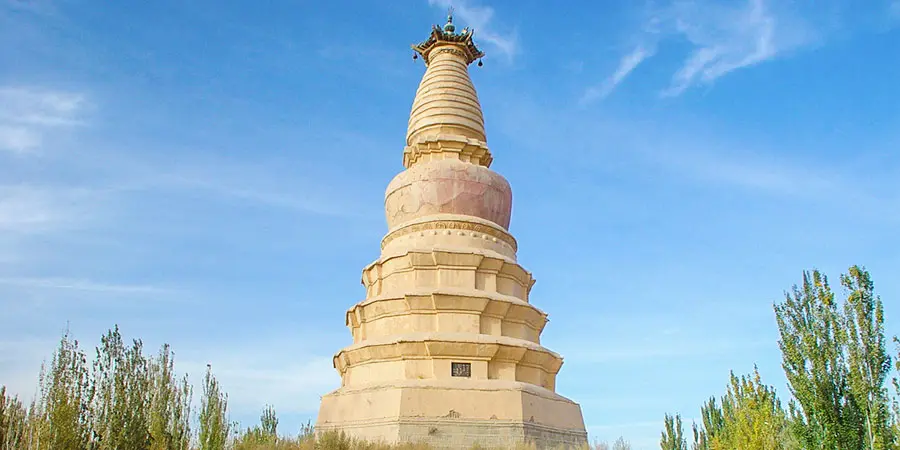White Horse Pagoda
If you are interested in Buddhism, you may wish to visit the White Horse Pagoda, also known as Baima Pagoda. As one of many popular places of interest in Dunhuang City, it is only 2km (1.2 miles) from the city center, so visitors can get there on foot or by taxi. First built in the 4th century and rebuilt in 1844 in the Qing Dynasty (1644 - 1911), it has been renovated several times by later generations. Hundreds of years old, the pagoda is still majestic, surrounded by green fields and trees and cyan-tiled houses.
The pagoda boasts of a time-honored history. It was built in memory of a loyal white horse owned by Kumarajiva, a master specializing in Buddhism. It is said that in 384, Fu Jian, the founder of the Former Qin Regime (350 - 394), invited Kumarajiva from the western regions to central China to spread Buddhism scriptures. When he reached the present Dunhuang City, his white horse got sick and died. The white horse had crossed the vast and desolate desert with Kumarajiva and had meant a lot to him. Upon its death, Kumarajiva felt very sorrowful. Therefore, he and local Buddhist followers raised money and had this dagoba built in 386. The structure has nine stories in total, implying that the horse died when it was nine years old.
The White Horse Pagoda takes the lama pagoda style of the Ming Dynasty (1368-1644). It is 12 meters (39.4 feet) high with an octagonal foundation. The whole building is built of mud bricks and the exterior is covered with mud and lime. Each story is very distinctive. The second to the fourth story have folding corners while the fifth is decorated with up-turned lotus petals. The sixth story resembles a big inverted alms bowl and the seventh is in the shape of a wheel. On each corner of the hexagonal roof hang bells that chime in the breeze. The eighth floor is a hexagonal plate with a bell hanging on each corner. Those bells always chime with the gentle breeze. The ninth is the spire with two balls.
On a sunny day, you will find the tall pagoda dominate the skyline. The pagoda is surrounded by farmlands, where you can have a close contact with Western China’s rural lifestyle. Behind the pagoda is the site of ancient Shazhou City which is barely recognizable. Historical vicissitudes are so relentless that the only thing we can do is to seize the day, seize the hour.
About 2km (1.2 miles) northeast of White Hourse Pagoda is Shazhou Night Market. It's great to have a hearty evening meal after a day of travelling. You can find sorts of local snacks and a rich collection of exquisite crafts.
1. Take Dunhuang Bus No. 1 to Danghe Lijing and then walk north for 5 minutes to the pagoda.
2. Take a taxi to get there from downtown and it takes no more than 5 minutes.
 Nearby Attractions:
Nearby Attractions:
 Dunhuang Museum
Dunhuang Museum
 |
Why Was White Horse Pagoda Built
Exterior Appearance of White Horse Pagoda
On a sunny day, you will find the tall pagoda dominate the skyline. The pagoda is surrounded by farmlands, where you can have a close contact with Western China’s rural lifestyle. Behind the pagoda is the site of ancient Shazhou City which is barely recognizable. Historical vicissitudes are so relentless that the only thing we can do is to seize the day, seize the hour.
About 2km (1.2 miles) northeast of White Hourse Pagoda is Shazhou Night Market. It's great to have a hearty evening meal after a day of travelling. You can find sorts of local snacks and a rich collection of exquisite crafts.
How to get to White Horse Pagoda
2. Take a taxi to get there from downtown and it takes no more than 5 minutes.
| Entrance Fee | CNY 15 |
|---|---|
| Opening Hours | 8:00-18:00 |
| Recommended Time for a Visit | 1h |
- Last updated on Aug. 05, 2025 by Demi Li -